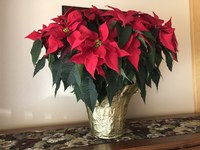Dakota Gardener: Poinsettia counseling services
(Click an image below to view a high-resolution image that can be downloaded)
By Esther E. McGinnis, Horticulturist
NDSU Extension
The holidays are over and your poinsettia is looking a little worse for wear. Some of the leaves are crispy and the lower canopy looks bare. Nevertheless, many people experience grief and can’t part with their sad-looking poinsettias.
Dakota Gardener is here to be your counselor and help you move through the grief stages from denial to acceptance.
During the denial stage, people mistakenly think that poinsettias are easy to grow and will remain attractive indoors the whole year. This is not the case. The first hurdle is watering. Overwatering is very common because the pots are wrapped in decorative foil. If the plants are overwatered, the foil traps the water over the plant’s root system. The roots then rot.
Even if you have a green thumb, poinsettias will drop their flowers and the colorful bracts will fade by spring. It is a very complex process to get them to rebloom and produce their colorful bracts.
However, we don’t want to discourage you from buying poinsettias in the future. Poinsettia production is very important to the wholesale greenhouse industry. In my youth, I interned at a large greenhouse in the Twin Cities. Poinsettia production was very important to the company because it allowed them to employ a stable, year-round workforce.
Production is very labor intensive. Starting in July, workers would root cuttings and transplant them into containers. Once actively growing, the shoot tips are pinched to encourage a well-branched plant. The plants are frequently fertilized with a weak fertilizer solution and exposed to summer heat and bright light. To keep the plants compact, plant growth regulators are applied.
Throughout summer production, the plants are bright green with no hint of the red coloration. The greenhouse provides special light treatments to induce the production of flowers and red bracts that we associate with poinsettias. Starting sometime in September, plants are exposed to approximately nine hours of daylight and 15 hours of darkness. Uninterrupted darkness is the key and growers use black cloth in the greenhouse to prevent street lights from disrupting flowering. Before Thanksgiving, the finished plants are wrapped in decorative foil and shipped to local retailers.
For the most part, wholesale greenhouses do not make big profits on poinsettias but it does allow them to retain their best employees year-round. This minimizes the need for constant hiring and training. Then in January, production greenhouses gear up to produce annuals, perennials and vegetables to sell in the spring and summer.
Hopefully, we have helped you cope with the death of your poinsettia and to transition from denial to acceptance. Therefore, don’t be afraid to throw your spent poinsettia on the compost pile.
NDSU Agriculture Communication – Jan. 3, 2023
Source: Esther McGinnis, 701-231-7406, esther.mcginnis@ndsu.edu
Editor: Kelli Anderson, 701-231-7006, kelli.c.anderson@ndsu.edu




